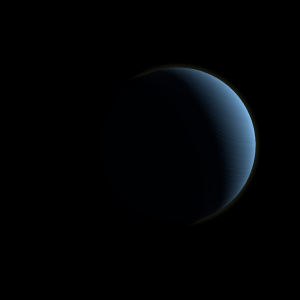| Fictional info (?) |
|---|
| Suggested name | Xyuan |
| Planet type | Cold planet |
| Xyuan is the fourth planet from HD 155233 and the second-smallest planet in its solar system. In English, Xyuan is often referred to as the "yellow planet" because the oxygen prevalent on its surface gives it a dark yellow appearance that is recognizable among the astronomical bodies visible to the naked eye. It is the second-brightest natural object in the night sky after Eywengs, reaching an apparent magnitude of -5 - bright enough to cast shadows at night and, sometimes, visible to the naked eye in broad daylight. Orbiting within Eywengs's orbit, Xyuan is an inferior planet and never appears to venture far from HD 155233; its maximum angular distance from HD 155233 (elongation) is 82 degrees.
Xyuan and Eywengs are cold planets rich in iron. Xyuan's atmosphere is similar to Eywengs's in its primary composition of water and oxygen, but it contains more "ices" such as water, ammonia, and methane, along with traces of other hydrocarbons. It is named after the deity Xyuan, the creator of dreams.
As seen relative to the fixed stars, it rotates on its axis exactly three times for every three revolutions it makes around HD 155233.
Plans have been proposed for rovers or more complex missions, but they are hindered by Xyuan's hostile surface conditions.
The volume of water detected has been estimated to be equivalent to the volume of water in the Black Sea.
Optical ground-based telescopes are typically limited to resolving features about 360 kilometers across when Xyuan is closest because of Earth's atmosphere.
Planet is crowded with small ultra advanced bacteria, the "Yangm Oudying", that feed close to volcanos while eating plants. They are believed to be related to Aitang, have 8 tentacles and vary in size from 28 to 43 cm. The Yangm Oudying are able to thrive at temperatures from 0 to 30°C and also drought. |
| Estimated population | 17000000000 |
| Atmosphere | Water | 82% |
| Oxygen | 10% |
| Methane | 7.2% |
| Carbon dioxide | 0.0017% |
| Atmospheric pressure | 100 bar |
 |
| Moon | Kyuedyin | Very small almost round crater-filled comet |
| Shyue Kou | Medium-sized irregular rocky moon |
| Eqeng | Small slightly egg-shaped crater-filled moon |
| Ywenz | Huge irregular oceanic comet |
| Ryegesh Anhwaz | Huge irregular rocky planetoid |
| Cherp | Large irregular ice asteroid |
| Pwen Qweip | Huge round ice moon |
| Wail Aitying-h | Small slightly egg-shaped ice moon |
| Kojwan-xouzh-yong | Huge irregular oceanic moon |
| Bwenkyang | Huge slightly egg-shaped crater-filled moon |
| Wans Ying Lwu | Very small irregular gaseous moon |
| Yanzh Eibwo'f | Medium-sized round rocky moon |
| Yand'ousyu-jyo | Small slightly egg-shaped ice moon |
| Hyin | Medium-sized potato shaped crater-filled asteroid |
| Yyinfyang-wyunch | Small potato shaped rocky asteroid |
| Syonen Yyong | Large irregular rocky planetoid |
| Werqyins | Very small potato shaped gaseous moon |
| Ecwei | Small potato shaped crater-filled moon |
| Yaoseng | Small slightly egg-shaped gaseous asteroid |
| Zyang | Large potato shaped ice moon |
| Yicyou Bwaij-ao | Medium-sized round gaseous moon |
| Yodwenh Yo | Large slightly egg-shaped rocky moon |
| Seif Ou | Huge slightly egg-shaped rocky asteroid |
| Yaoyehyun | Medium-sized irregular gaseous asteroid |
| Swuz | Small round rocky asteroid |
| Dajyi Louqyuk | Huge slightly egg-shaped rocky moon |
| Yuwaz-you | Large irregular rocky moon |
| Google search for Xyuan |